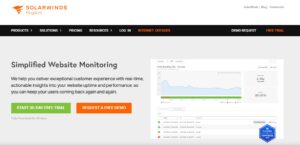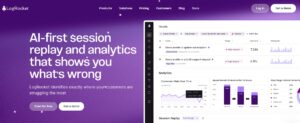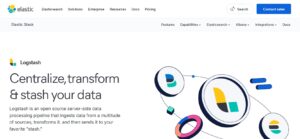SpeedCurve is a web performance monitoring platform known for its strong Real User Monitoring (RUM) and Synthetic Monitoring capabilities. However, it focuses narrowly on front-end monitoring, lacks full-stack observability, and does not support APM, logs, infrastructure monitoring, or OpenTelemetry (OTEL). Pricing can escalate with data volume, and the absence of self-hosting limits compliance with data localization requirements.
CubeAPM is the best alternative to SpeedCurve, delivering full MELT observability with OTEL support, self-hosting, smart sampling, and flat $0.15/GB pricing—at up to 80% lower cost than legacy vendors. It combines front-end and backend monitoring in one platform, eliminating the need for multiple tools.
In this article, we compare the top SpeedCurve alternatives, including CubeAPM, New Relic and more, highlighting their features and pricing, to help you choose the right APM solution.
Table of Contents
ToggleTop 7 SpeedCurve Alternatives
- CubeAPM
- New Relic
- Better Stack
- Dynatrace
- Datadog
- Grafana
- Coralogix
Why Look for SpeedCurve Alternatives?
Why SpeedCurve Users Should Also Use an APM Tool
SpeedCurve excels at monitoring front-end performance—metrics like Core Web Vitals, page speed, and user experience from the browser’s perspective—but it doesn’t provide deep visibility into server-side performance, application code, database queries, or infrastructure bottlenecks. Pairing it with an APM tool gives you full-stack observability, so you can trace slow user experiences back to backend root causes, monitor APIs and microservices, and proactively detect issues before they impact real users. This combination ensures both the “front door” (UX) and the “engine room” (backend) of your application are optimized.
6 Reasons to Look for SpeedCurve Alternatives
Organizations are increasingly seeking SpeedCurve alternatives due to the following limitations:
- No Full APM Coverage
SpeedCurve does not offer distributed tracing, backend performance monitoring, or infrastructure visibility. Teams still need a separate APM solution to track server-side performance. - No Logs or MELT Stack Support
While SpeedCurve captures front-end performance metrics, it does not collect logs or traces, making it unsuitable for end-to-end debugging. - Limited Error Tracking
Error detection is mostly tied to failed synthetic tests and RUM anomalies, with no advanced error grouping, root-cause analysis, or session correlation. - No OpenTelemetry Support
With 41% of organizations already using OTEL in production and another 38% evaluating it (CNCF Survey 2024), the lack of OTEL integration limits interoperability and vendor-agnostic observability. - Pricing and Scalability
Plans start at $90/month for limited feature sets, with higher tiers ($576/month and above) required for longer retention and priority support. This can be cost-prohibitive for organizations scaling synthetic and RUM data capture. - No Self-Hosting Option
All data is processed in SpeedCurve’s infrastructure. For regulated sectors, this poses compliance issues, especially where data localization laws require all telemetry to remain within specific jurisdictions.
Criteria for Suggesting SpeedCurve Alternatives
When selecting alternatives to SpeedCurve, we evaluated tools using the following criteria:
- Full-Stack Observability
The alternative must support APM, RUM, logs, metrics, traces, and error tracking—allowing teams to monitor both front-end and backend in a unified interface. - OpenTelemetry & Vendor Neutrality
OTEL-native tools are prioritized to avoid vendor lock-in, improve data portability, and enable integration with existing pipelines. - Deployment Flexibility
Support for both SaaS and self-hosted/on-prem deployments to meet security, compliance, and cost optimization needs. - Cost Efficiency & Transparent Pricing
Flat-rate or usage-based pricing models that scale without unpredictable overage bills, plus detailed cost breakdowns. For example, CubeAPM offers data ingestion at $0.15/GB vs. $0.35–$0.42/GB for incumbents like Datadog and New Relic. - Smart Sampling & Data Retention
Advanced sampling methods (like CubeAPM’s context-aware smart sampling) help retain critical traces while reducing storage costs. Longer data retention without exorbitant archival fees is a key advantage. - Compliance & Data Localization
Ability to store data entirely in the customer’s cloud (CubeAPM), reducing transfer costs and meeting compliance laws. By contrast, Coralogix’s model of archiving telemetry to the customer’s cloud reduces storage costs, but still incurs public egress fees and fails data localization since the data first leaves the region.
SpeedCurve Overview
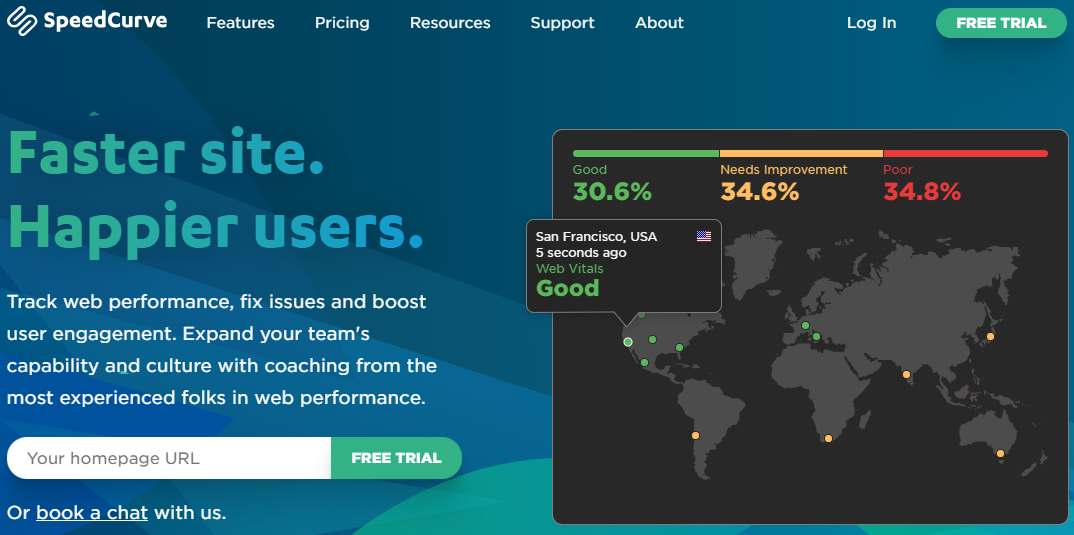
Known for:
SpeedCurve is known for front-end performance monitoring, specializing in Real User Monitoring (RUM) and Synthetic Monitoring to measure and improve Core Web Vitals, page load times, and visual performance metrics.
Standout Features:
- Core Web Vitals Tracking: Monitors Google’s key performance indicators like LCP, FID, and CLS.
- Filmstrips & Visualizations: Provides side-by-side visual comparisons of page load sequences.
- Synthetic & RUM Blend: Combines lab-based synthetic tests with real user data for a fuller picture.
- Performance Budgets: Allows teams to set and enforce limits for load times, size, and requests.
Key Features:
- Real User Monitoring (RUM): JavaScript snippet (lux.js) to collect real-time user performance metrics.
- Synthetic Monitoring: Scheduled tests from multiple regions and browsers to detect regressions.
- Core Web Vitals Reporting: Direct tracking and trend analysis for LCP, FID, and CLS.
- Performance Budget Alerts: Notifications when performance metrics exceed thresholds.
- Third-party Impact Analysis: Measures the effect of third-party scripts on performance.
- Deploy-triggered Tests: Automatic synthetic tests triggered during deployment.
Pros:
- Strong focus on front-end and user experience metrics
- Clear visualizations like filmstrips and waterfalls for performance debugging
- Combines synthetic and real-user data for better context
- Easy setup with a single JavaScript snippet for RUM
- Flexible test scheduling and regional targeting
Cons:
- No backend APM, logs, or infrastructure monitoring
- No OpenTelemetry support, limiting integration flexibility
- No MELT stack coverage—metrics, events, logs, and traces not unified
- Error tracking limited to failed synthetic runs and RUM anomalies
- No self-hosting option, making data localization compliance difficult
- Pricing scales quickly with data volume and advanced feature needs
Best for:
Teams focused exclusively on front-end performance optimization who do not require backend monitoring or full-stack observability, such as web performance engineers, UX specialists, and SEO optimization teams.
Pricing & Customer Reviews:
- Starter Plan: From $90/month – includes unlimited teams, RUM, and synthetic monitoring
- Growth Plan: From $576/month – adds 13 months retention, high-priority support, and synthetic priority testing
- Enterprise Plan: From $1,680/month – adds SSO, private agents, check-ins, and consulting
- G2 Rating: 5/5 – Users praise its clear visualizations and ease of use, but note high costs and missing backend monitoring capabilities.
1. CubeAPM
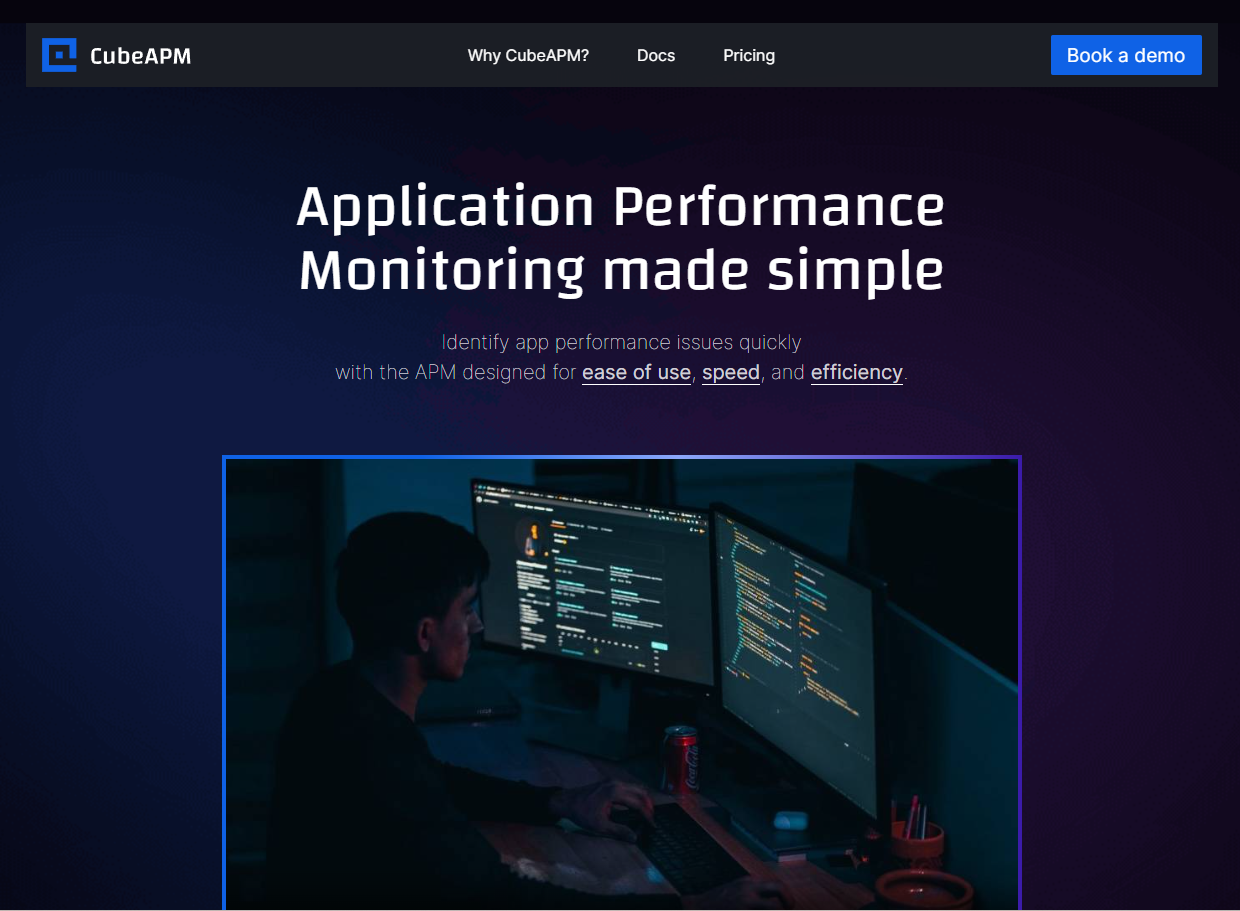
Known for:
Full-stack observability and APM with a focus on cost efficiency, data compliance, and OpenTelemetry-native support.
Key Features:
- Application Performance Monitoring (APM): Distributed tracing with deep transaction insights.
- Real User Monitoring (RUM): Browser-level performance metrics with Core Web Vitals tracking.
- Log Monitoring: Centralized log management with powerful search and filtering.
- Infrastructure Monitoring: Server, container, and Kubernetes resource metrics.
- Synthetic Monitoring: Unlimited tests for uptime, availability, and latency.
- Error Tracking: Real-time error detection and correlation with trace data.
Standout Features:
- Smart Sampling: Context-aware sampling that prioritizes high-latency, error-heavy traces while reducing cost.
- Self-Hosting: Option to store all telemetry in your own cloud for compliance and reduced egress costs.
- Flat-Rate Pricing: $0.15/GB ingestion, significantly cheaper than most legacy vendors.
- High Compatibility: Works with Datadog, New Relic, Prometheus, and Elastic agents out of the box.
Pros:
- 60–80% cheaper than major vendors
- Full MELT coverage (Metrics, Events, Logs, Traces)
- Native OTEL and Prometheus support
- Fast support via Slack/WhatsApp with core developers
- Compliant with data localization laws
Cons:
- Not suited for teams looking for off-prem solutions
- Strictly an observability platform and does not support cloud security management
Best for:
Organizations seeking full-stack observability at predictable, low cost with strong compliance capabilities, especially in regulated sectors like finance, healthcare, and government.
Pricing & Customer Reviews:
- Pricing: flat pricing of $0.15/GB ingestion
- G2 Rating: 4.8/5(Based on feedback from Slack and end-uses testimonials)
CubeAPM vs SpeedCurve:
While SpeedCurve excels at front-end performance monitoring, it lacks backend APM, logs, infrastructure monitoring, and OpenTelemetry support. CubeAPM provides all of these in one platform, combining front-end and backend monitoring with compliance-friendly self-hosting—at a fraction of the cost of running multiple separate tools.
2. New Relic

Known for:
New Relic is a full-stack observability covering APM, infrastructure monitoring, logs, and RUM with a SaaS-first deployment model.
Key Features:
- APM: Distributed tracing, service maps, and transaction performance analytics.
- RUM: Core Web Vitals tracking and end-user performance insights.
- Infrastructure Monitoring: Server and container metrics.
- Log Management: Centralized logs with search and analytics.
- Synthetic Monitoring: Simulated transactions and uptime testing.
- Errors Inbox: Error aggregation and alerting.
Standout Features:
- Unified Telemetry Platform: Combines metrics, events, logs, and traces in one interface.
- AI-assisted Insights: Automatic anomaly detection and root cause analysis.
- Wide Agent Support: Multiple languages and environments supported.
Pros:
- Broad observability coverage
- Long-standing vendor with mature integrations
- Rich visualization and reporting tools
- AI-driven detection and insights
Cons:
- Higher ingestion cost ($0.30–$0.42/GB) and user license fees
- Data stored outside certain jurisdictions—compliance risk
- Limited retention unless paying for premium tiers
Best for:
Large enterprises seeking a feature-rich SaaS observability platform with extensive ecosystem integrations.
Pricing & Customer Reviews:
- Pricing:
- Free Tier: 100GB ingested per month
- Ingestion from $0.30+/GB, $400/user/month for full access; additional charges for longer retention
- G2 Rating: 4.4/5 – Praised for rich feature set, criticized for complex pricing and costs at scale.
New Relic vs SpeedCurve:
While SpeedCurve focuses on front-end metrics, New Relic offers full-stack observability with deep backend insights, log management, and AI features. However, New Relic’s cost and licensing complexity can make it overkill for teams seeking a focused, affordable solution.
3. Better Stack

Known for:
Modern log management and uptime monitoring with a strong focus on developer experience.
Key Features:
- Log Management: Structured log storage with SQL-like querying.
- Uptime Monitoring: Global endpoint checks and incident alerts.
- Status Pages: Customizable, public-facing service status dashboards.
- Integrations: Slack, PagerDuty, and GitHub integration for alerts.
- Metrics Dashboards: Real-time visualization of system health.
Standout Features:
- SQL for Logs: Query logs using familiar SQL syntax.
- Beautiful Dashboards: Developer-friendly, visually polished UI.
- Fast Setup: Minimal overhead for onboarding and integrations.
Pros:
- Quick to set up and use
- Affordable log management
- Strong alerting and status page features
Cons:
- No native APM or RUM capabilities
- Limited infrastructure and synthetic monitoring depth
Best for:
Startups and mid-size teams looking for clean log management, status pages, and uptime monitoring without heavy APM needs.
Pricing & Customer Reviews:
- Pricing: Free tier: includes 10 monitors & heartbeats, Slack & E-mail alerts, 3 GB logs retained for 3 days
- Logs: $2.50/GB (standard ingest)
- Paid from $29/month depending on log volume and monitoring checks
- G2 Rating: 4.8/5 – Users love the ease of use and visual design, but want deeper backend observability features.
Better Stack vs SpeedCurve:
SpeedCurve focuses on front-end performance, whereas Better Stack is more about logs, uptime monitoring, and incident communication. Teams seeking a single tool for RUM and backend monitoring will still need additional platforms.
4. Dynatrace
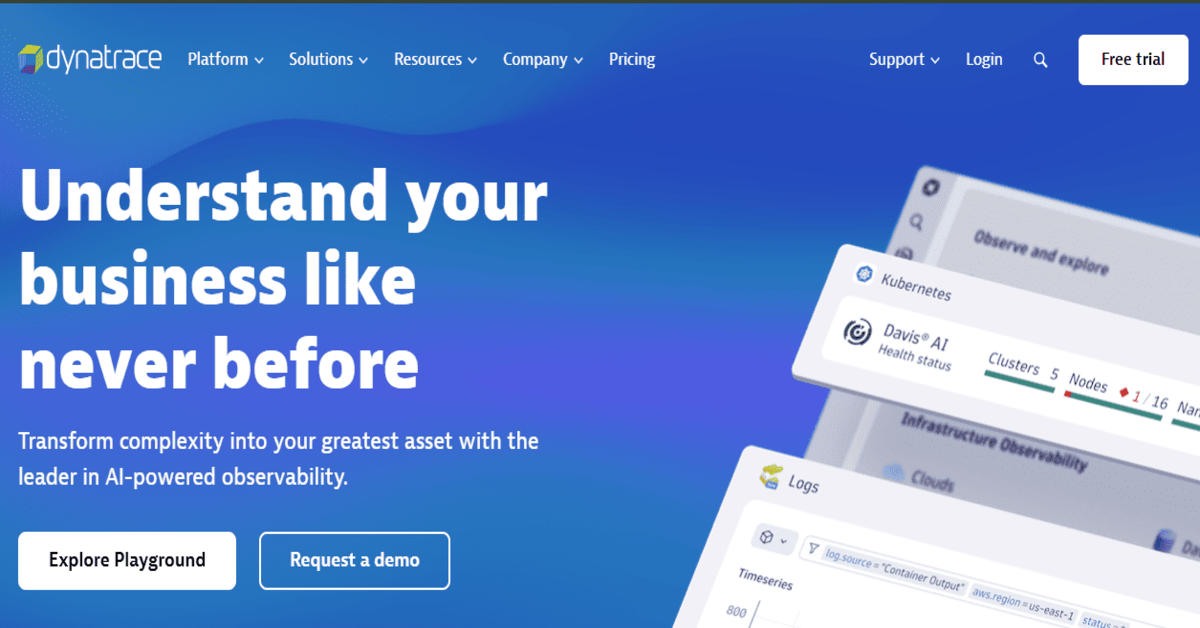
Known for:
Dynatrace is an enterprise-grade, AI-powered observability platform with strong automation and auto-discovery capabilities.
Key Features:
- APM: Distributed tracing, code-level diagnostics, and service flow mapping.
- Infrastructure Monitoring: Automated topology discovery and dependency mapping.
- Digital Experience Monitoring: RUM and synthetic tests for web and mobile.
- Logs & Events: Ingest, search, and analyze logs alongside metrics.
- AI Engine (Davis): Automated anomaly detection and root cause analysis.
Standout Features:
- Automatic Instrumentation: Zero-config setup for supported environments.
- AI-Driven Analytics: Reduces noise and speeds up incident response.
- Enterprise Scalability: Designed for massive, complex environments.
Pros:
- All-in-one enterprise observability
- Strong automation and AI capabilities
- Comprehensive data correlation across MELT
Cons:
- High cost and steep learning curve
- Can be overkill for smaller teams
- Limited flexibility in deployment models
Best for:
Large enterprises needing high automation, scalability, and AI-driven incident management.
Pricing & Customer Reviews:
- Pricing:$0.08/hour per 8 GiB host (~$57.60/host/month)
- G2 Rating: 4.5/5 – Praised for automation, criticized for complexity and pricing.
Dynatrace vs SpeedCurve:
Dynatrace covers full-stack observability with enterprise automation, far beyond SpeedCurve’s front-end focus. However, the complexity and cost may not suit teams wanting a lightweight, affordable solution.
5. Datadog

Known for:
Datadog is a comprehensive observability platform with APM, logs, infrastructure monitoring, and security features.
Key Features:
- APM & Tracing: Detailed service performance monitoring.
- Logs: Centralized logging with analytics and archiving.
- Infrastructure Monitoring: Metrics for servers, containers, and cloud resources.
- RUM & Synthetics: End-user monitoring and API checks.
- Security Monitoring: Threat detection and compliance dashboards.
Standout Features:
- Wide Integration Ecosystem: 900+ built-in integrations.
- Custom Dashboards: Flexible visualization and monitoring.
- Multi-Product Bundling: Security, APM, logs, and infra in one interface.
Pros:
- Extensive integrations and ecosystem
- Unified platform for multiple observability needs
- Mature product with large community
Cons:
- High ingestion cost and separate fees for synthetics, logs, and error tracking
- Pricing complexity can lead to unexpected overruns
- Limited self-hosting options
Best for:
Teams seeking a wide integration ecosystem with centralized monitoring across APM, logs, and infra.
Pricing & Customer Reviews:
- Pricing:
- APM: starts at $31/host/month;
- logs – Effective Cost: $0.1/GB + $1.7/M events (15d),
- synthetics billed separately;
- Infra Cost; starting at $15/host/month
- G2 Rating: 4.4/5 – Praised for integrations and UI, criticized for cost predictability.
Datadog vs SpeedCurve:
Datadog offers broader coverage with full-stack observability and security, whereas SpeedCurve is more specialized in front-end performance. Datadog’s complexity and cost can be a hurdle for smaller teams.
6. Grafana

Known for:
Grafana is an open-source visualization platform with strong metrics and dashboarding capabilities.
Key Features:
- Metrics Visualization: Custom dashboards for Prometheus, Graphite, InfluxDB, etc.
- Alerting: Flexible rules and notification channels.
- Plugins: Community and enterprise plugin ecosystem.
- Data Source Integrations: Connects to multiple backends.
Standout Features:
- Highly Customizable Dashboards: Rich visualization options.
- Open-Source Core: Free to use, with Grafana Cloud and Enterprise options.
Pros:
- Free open-source version
- Wide integration with data sources
- Strong community support
Cons:
- No native APM or logs (needs other tools)
- Steeper setup curve for new users
- Advanced features often require paid tiers
Best for:
Teams that want rich visualization and have an existing observability backend.
Pricing & Customer Reviews:
- Pricing:
- Free: All Grafana Cloud services, limited usage, 14 days retention
- Pro: $19/ month + usage, 8X5 email support 13 months retention for metrics; 30 days retention for logs;
- Enterprise: $25,000/ year , Premium support, Custom retention, Deployment flexibilita
- G2 Rating: 4.5/5 – Praised for flexibility, criticized for initial setup complexity.
Grafana vs SpeedCurve:
Grafana is best for visualization of diverse metrics, while SpeedCurve’s strength lies in synthetic and RUM-based performance tracking. They serve different primary purposes but can complement each other.
7. Coralogix

Known for:
Log analytics and observability with a unique data lifecycle cost model.
Key Features:
- Log Management: Structured and unstructured log ingestion.
- Metrics & Traces: Full observability data support.
- Data Tiers: Live, Warm, and Archived data separation for cost optimization.
- Real-Time Alerting: Instant notifications on anomalies and threshold breaches.
- Security & Compliance: Features for regulated industries.
Standout Features:
- Archived Telemetry in Customer Cloud: Reduces storage costs by storing archived data in the customer’s own cloud.
- Flexible Data Retention Policies: Custom retention rules for different data tiers.
- Integrated Observability Suite: Combines logs, metrics, traces, and security analytics.
Pros:
- Cost savings on archived data storage
- Full observability stack with integrated security
- Flexible retention and tiered storage options
Cons:
- Archived data still incurs public egress cost before moving to customer cloud
- Data localization compliance issues since data leaves the region before archival
- Higher cost for live data storage compared to cold storage
Best for:
Organizations needing robust log management and observability with long-term archival cost optimization.
Pricing & Customer Reviews:
- Pricing:
- Logs: $0.52/GB, infinite retention
- Traces: $0.44/GB, infinite retention
- Metrics:$0.05/GB, infinite retention
- AI: 1.5 per 1M tokens
- G2 Rating: 4.6/5 – Praised for cost-saving model and flexible data management, with some concerns about egress costs and compliance.
Coralogix vs SpeedCurve:
While SpeedCurve focuses on web performance metrics, Coralogix offers a broader observability suite with logs, metrics, and traces. Coralogix’s archival model can reduce storage costs, but compliance and egress fees should be considered.
Conclusion
While SpeedCurve is a strong choice for front-end performance monitoring, it falls short in delivering full-stack observability, lacking backend APM, logs, infrastructure monitoring, and OpenTelemetry support. The alternatives discussed offer broader capabilities, flexible deployment options, and more predictable pricing, making them better suited for organizations that need end-to-end visibility and scalability.
CubeAPM stands out as the best alternative, delivering complete MELT coverage—APM, RUM, logs, infrastructure, synthetics, and error tracking—in one cost-efficient, OTEL-native platform. With flat $0.15/GB pricing, smart sampling, and self-hosting for compliance, CubeAPM eliminates the need for multiple tools while cutting monitoring costs by up to 80%.

